parking brake CHEVROLET EXPRESS 1997 1.G User Guide
[x] Cancel search | Manufacturer: CHEVROLET, Model Year: 1997, Model line: EXPRESS, Model: CHEVROLET EXPRESS 1997 1.GPages: 386, PDF Size: 20.32 MB
Page 114 of 386
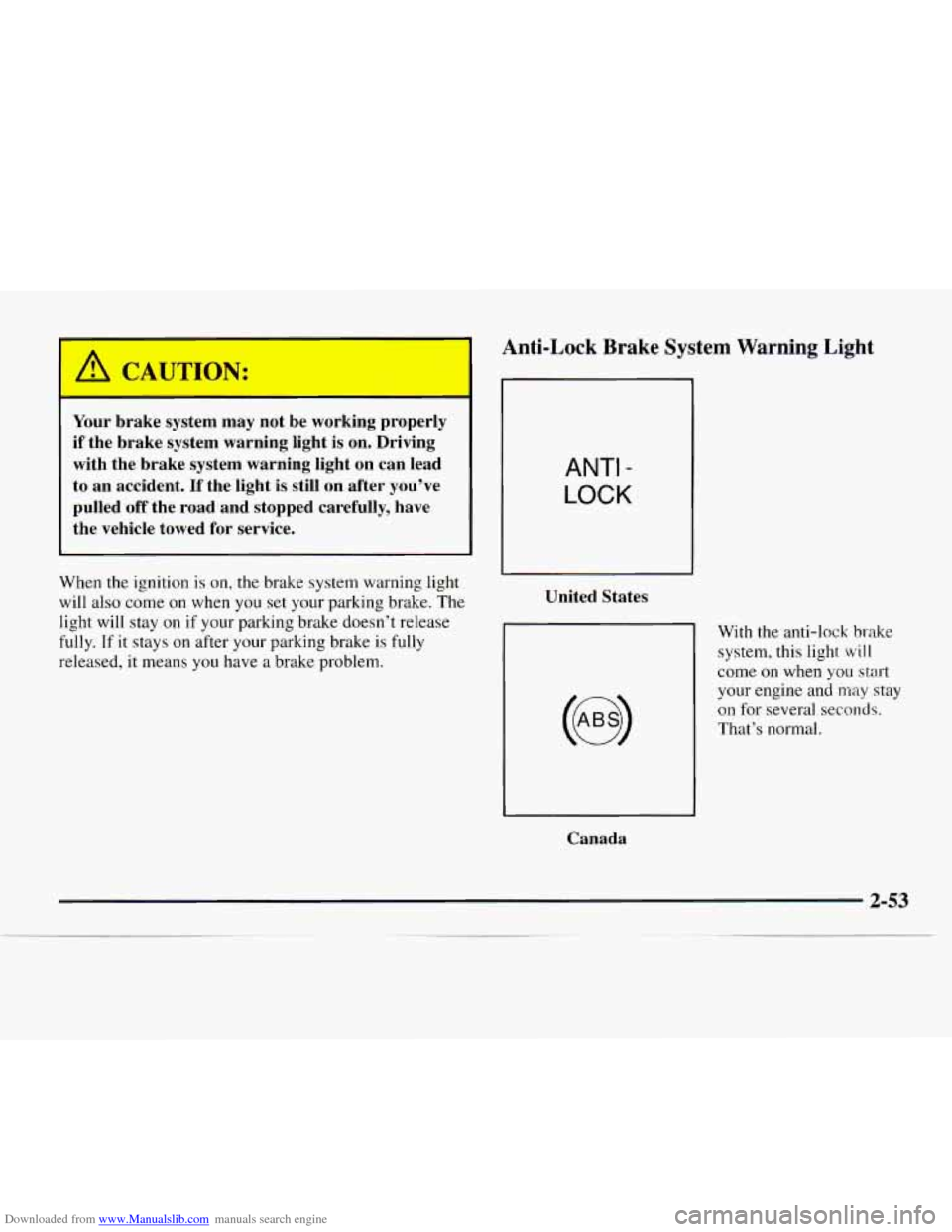
Downloaded from www.Manualslib.com manuals search engine A CAUTIOd:
2
Your brake system may not be working properly
if the brake system warning light is on. Driving
with the brake system warning light
on can lead
to an accident.
If the light is still on after you’ve
pulled off the road and stopped carefully, have
the vehicle towed for service.
When the ignition is on, the brake system warning light
will also come
on when you set your parking brake. The
light will stay on
if your parking brake doesn’t release
fully. If it stays on after your parking brake is fully
released, it means you have a brake problem.
Anti-Lock Brake System Warning Light
ANTI -
LOCK
United States
Canada
With the anti-lock brake system, this light
will
come on when you start
your engine and may stay
on for several
seconds.
That’s normal.
Page 190 of 386
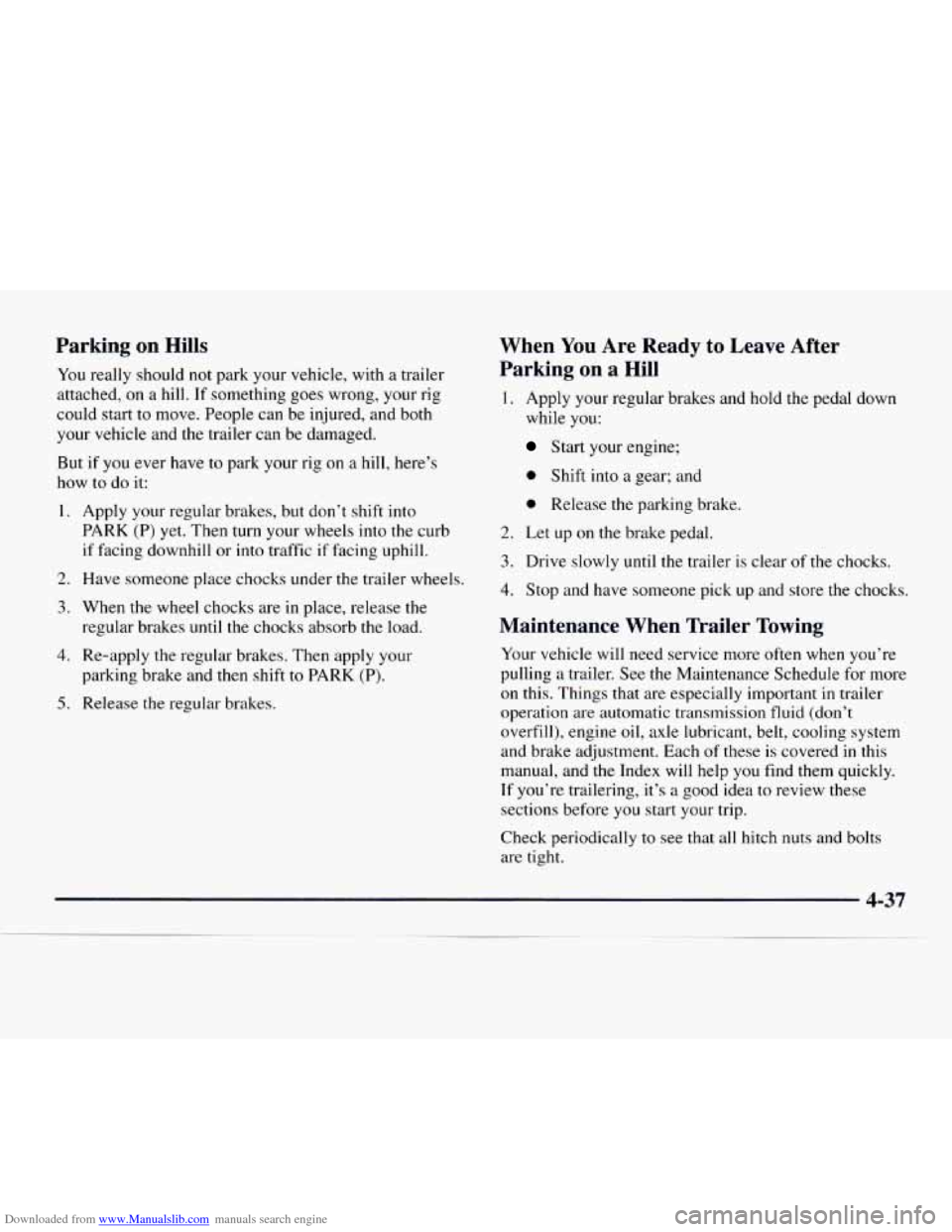
Downloaded from www.Manualslib.com manuals search engine Parking on Hills
You really should not park your vehicle, with a trailer
attached, on a hill. If something goes wrong, your rig
could start
to move. People can be injured, and both
your vehicle and the trailer can be damaged.
But if
you ever have to park your rig on a hill, here’s
how
to do it:
1.
2.
3.
4.
5.
Apply your regular brakes, but don’t shift into
PARK
(P) yet. Then turn your wheels into the curb
if facing downhill or into traffic if facing uphill.
Have someone place chocks under the trailer wheels.
When the wheel chocks are in place, release the
regular brakes until
the chocks absorb the load.
Re-apply the regular brakes. Then apply your
parking brake and then shift to PARK
(P).
Release the reguIar brakes.
When You Are Ready to Leave After
Parking on a Hill
I. Apply your regular brakes and hold the pedal down
while
you:
Start your engine;
0 Shift into a gear; and
0 Release the parking brake.
2. Let up on the brake pedal.
3. Drive slowly until the trailer is clear of the chocks.
4. Stop and have someone pick up and store the chocks.
Maintenance When Trailer Towing
Your vehicle will need service more often when you’re
pulling a trailer. See
the Maintenance Schedule for more
on this. Things that are especially important in trailer
operation are automatic transmission fluid (don’t
overfill), engine oil, axle lubricant, belt, cooling system
and brake adjustment. Each
of these is covered in this
manual, and the Index will help you find them quickly.
If you’re trailering, it’s a good idea to review these
sections before you start your trip.
Check periodically
to see that all hitch nuts and bolts
are tight.
Page 191 of 386
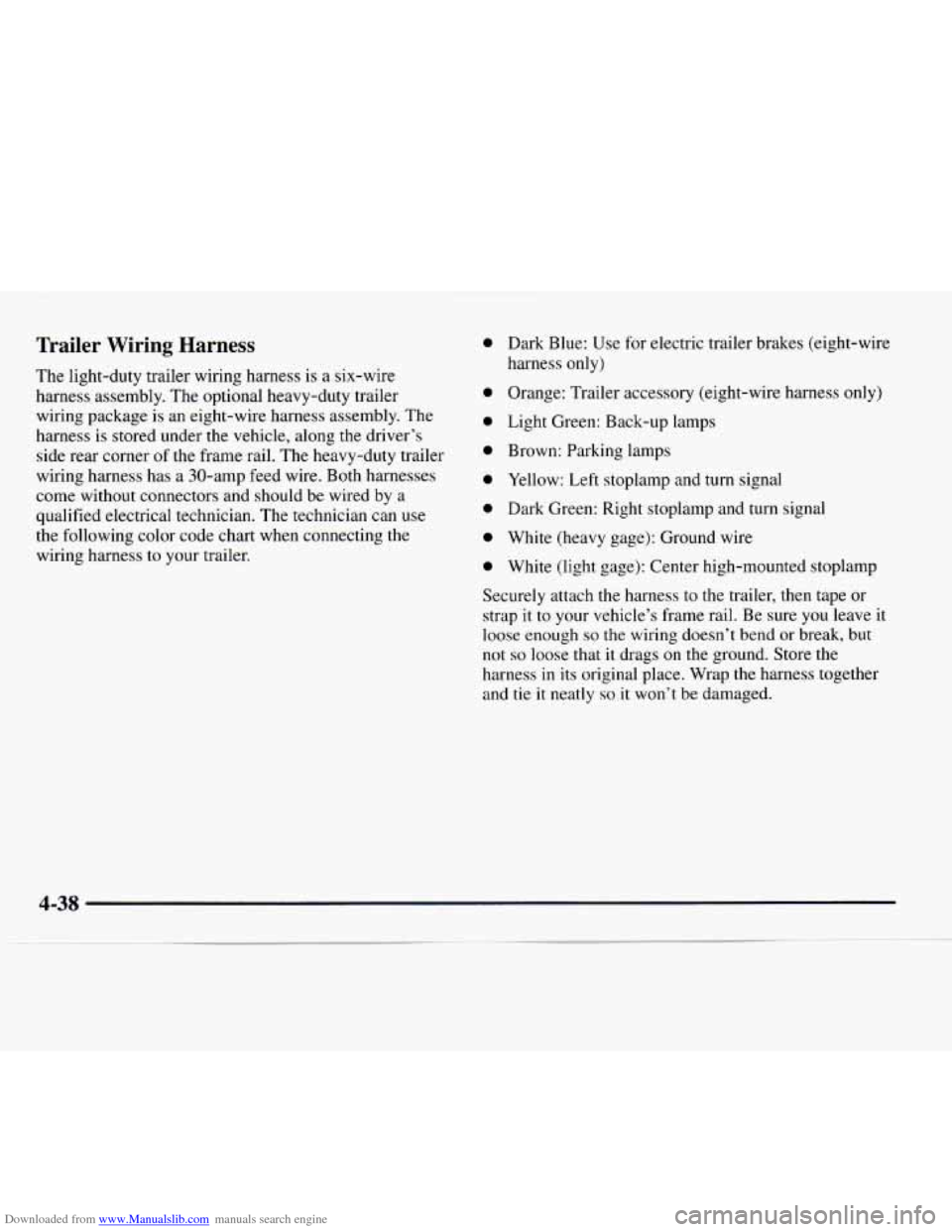
Downloaded from www.Manualslib.com manuals search engine Trailer Wiring Harness
The light-duty trailer wiring harness is a six-wire
harness assembly. The optional heavy-duty trailer
wiring package is an eight-wire harness assembly. The
harness is stored under the vehicle, along the driver’s
side rear corner of the frame rail.
The heavy-duty trailer
wiring harness has a 30-amp feed wire. Both harnesses
come without connectors and should be wired by a
qualified electrical technician. The technician can use
the following color code chart when connecting the
wiring harness to your trailer.
0
0
0
0
0
0
0
0
Dark Blue: Use for electric trailer brakes (eight-wire
harness only)
Orange: Trailer accessory (eight-wire harness only)
Light Green: Back-up lamps
Brown: Parking lamps
Yellow: Left stoplamp and turn signal
Dark Green: Right stoplamp and turn signal
White (heavy gage): Ground wire
White (light gage): Center high-mounted stoplamp
Securely attach the harness to the trailer, then tape or
strap it
to your vehicle’s frame rail. Be sure you leave it
loose enough
so the wiring doesn’t bend or break, but
not
so loose that it drags on the ground. Store the
harness in its original place. Wrap
the harness together
and
tie it neatly so it won’t be damaged.
Page 197 of 386
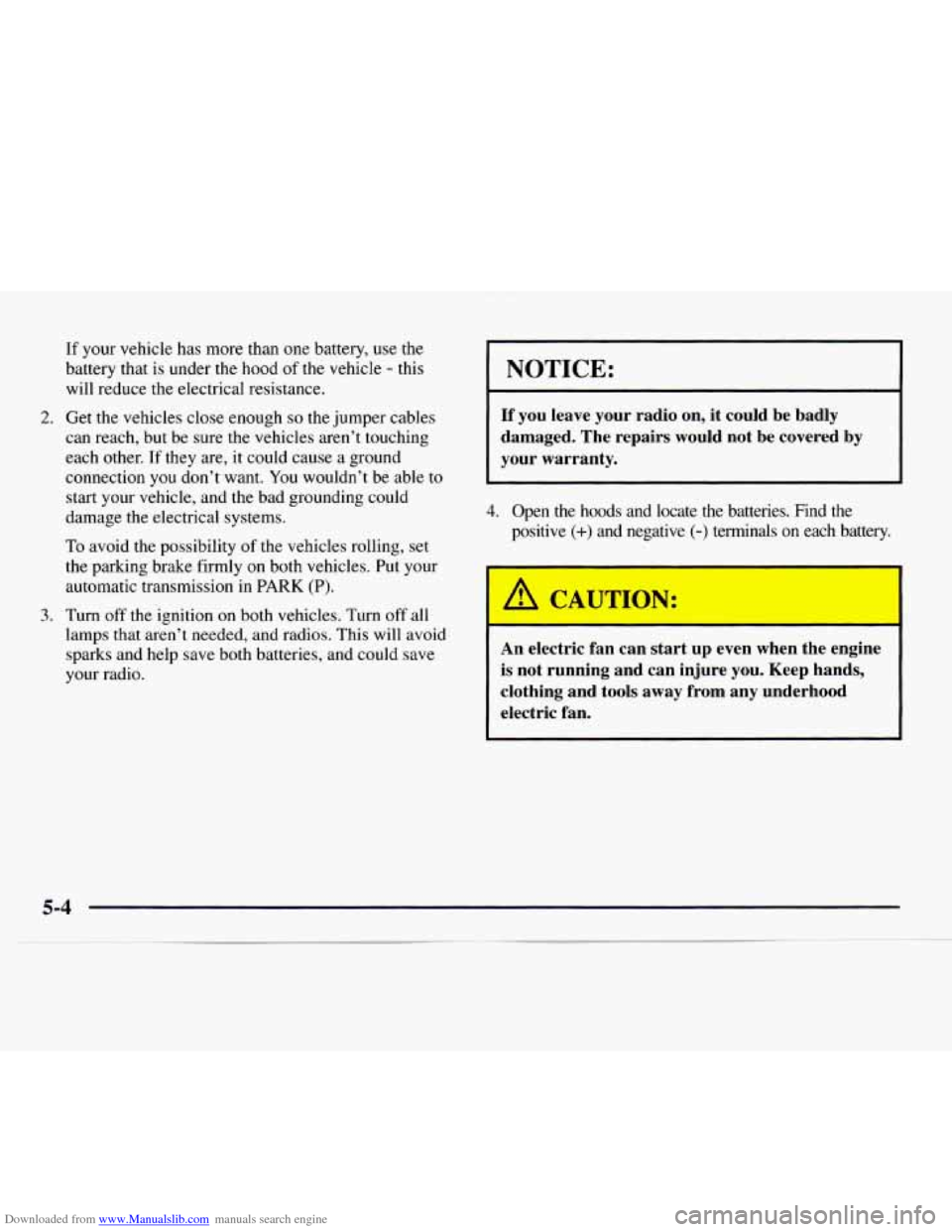
Downloaded from www.Manualslib.com manuals search engine If your vehicle has more than one battery, use the
battery that is under the hood of the vehicle
- this
will reduce the electrical resistance.
2. Get the vehicles close enough so the jumper cables
can reach, but be sure the vehicles aren’t touching
each other.
If they are, it could cause a ground
connection
you don’t want. You wouldn’t be able to
start your vehicle, and the bad grounding could
damage the electrical systems.
To avoid the possibility of the vehicles rolling, set
the parking brake firmly on both vehicles. Put your
automatic transmission in PARK
(P).
3. Turn off the ignition on both vehicles. Turn off all
lamps that aren’t needed, and radios. This will avoid
sparks and help save both batteries, and could save
your radio.
1 NOTICE:
If’ you leave your radio on, it could be badly
damaged. The repairs would not be covered by
your warranty.
4. Open the hoods and locate the batteries. Find the
positive
(+) and negative (-) terminals on each battery.
An electric fan can start up even when the engine
is not running and can injure you. Keep hands,
clothing and tools away from any underhood
electric fan.
Page 202 of 386
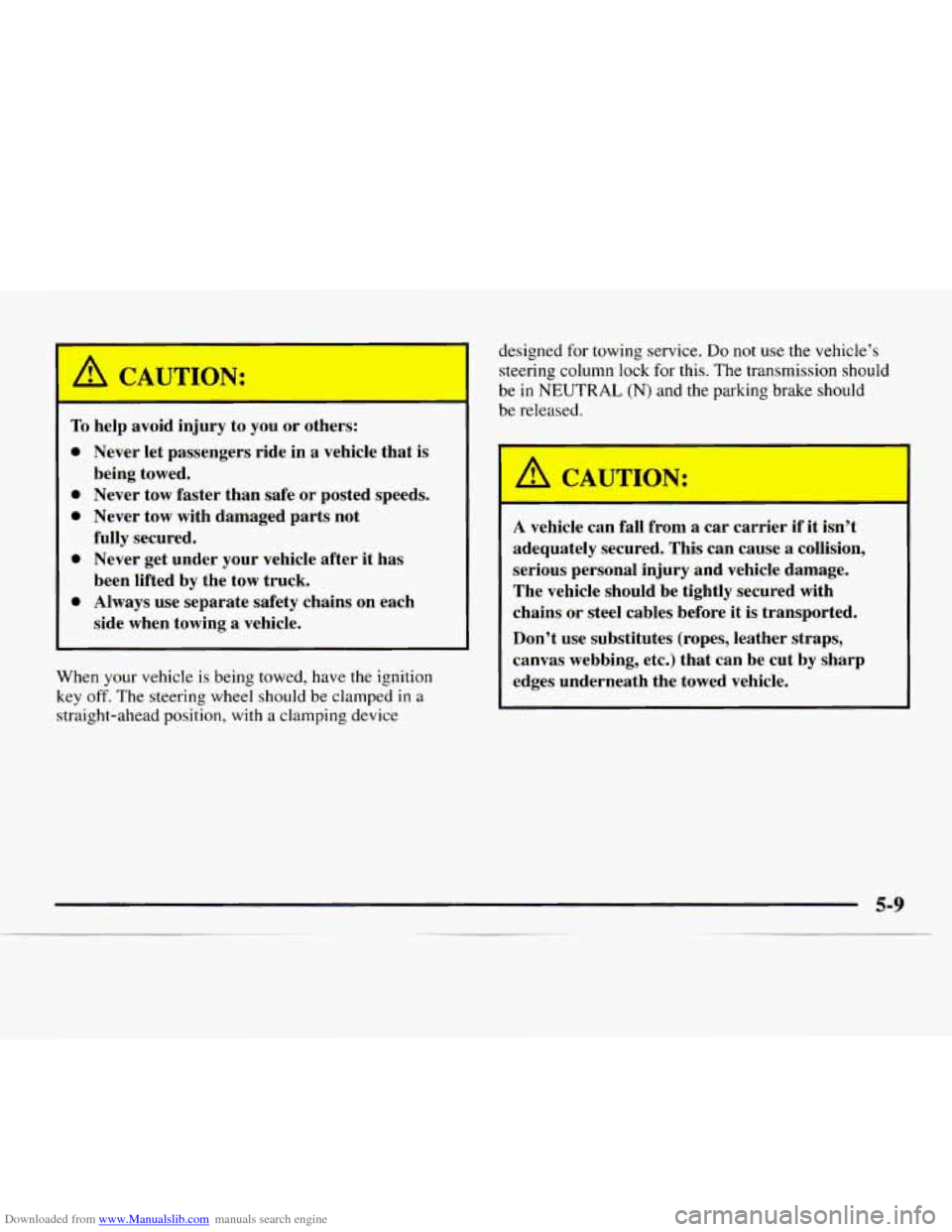
Downloaded from www.Manualslib.com manuals search engine I I
’ A CAUTIO--:
- - -
To help avoid injury to you or others:
0
0
0
0
0
Never let passengers ride in a vehicle that is
being towed.
Never tow faster than safe or posted speeds.
Never tow with damaged parts not
fully secured. Never get under your vehicle after it has
been lifted by the tow truck.
Always use separate safety chains on each
side when towing a vehicle.
When your vehicle is being towed, have the ignition
key
off. The steering wheel should be clamped in a
straight-ahead position, with a clamping device
I designed for towing service. Do not use the vehicle’s
steering column lock for this. The transmission should
be
in NEUTRAL (N) and the parking brake should
be released.
A
,!1 CAUTION:
A vehicle can fall from a car carrier if it isn’t
adequately secured. This can cause a collision,
serious personal injury and vehicle damage.
The vehicle should be tightly secured with
chains or steel cables before it is transported.
Don’t use substitutes (ropes, leather straps,
canvas webbing, etc.) that can be cut by sharp
edges underneath the towed vehicle.
Page 216 of 386
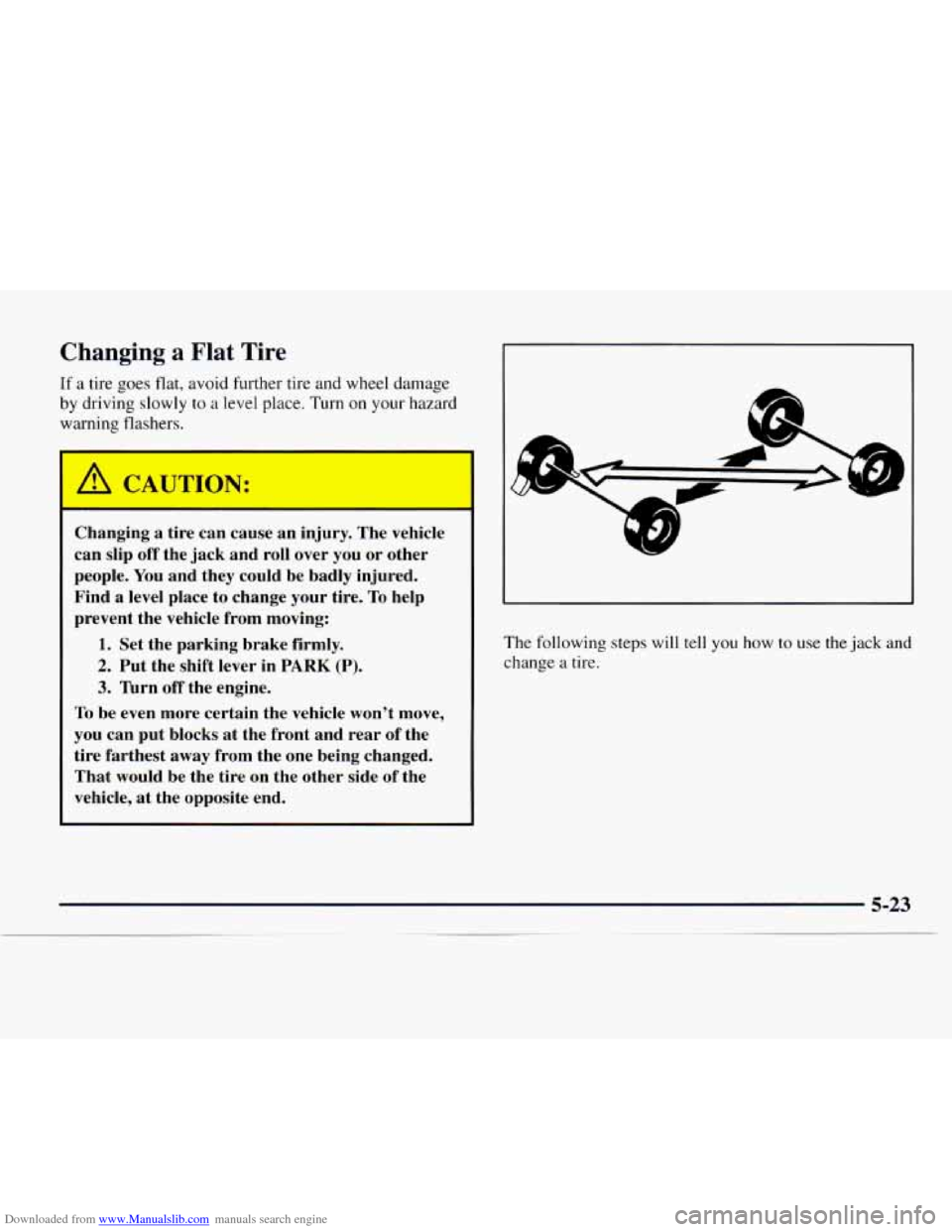
Downloaded from www.Manualslib.com manuals search engine Changing a Flat Tire
If a tire goes flat, avoid further tire and wheel damage
by driving slowly to
a level place. Turn on your hazard
warning flashers.
a CAUl ION:
Changing a tire can cause an injury. The vehicle
can slip off the jack and roll over you or other
people. You and they could be badly injured.
Find
a level place to change your tire. To help
prevent the vehicle from moving:
1. Set the parking brake firmly.
2. Put the shift lever in PARK (P).
3. Turn off the engine.
To be even more certain the vehicle won’t move,
you can put blocks at the front and rear of the
tire farthest away from the one being changed.
That would be the tire
on the other side of the
vehicle,
at the opposite end.
The following steps will tell you how to use the jack and
change
a tire.
Page 253 of 386
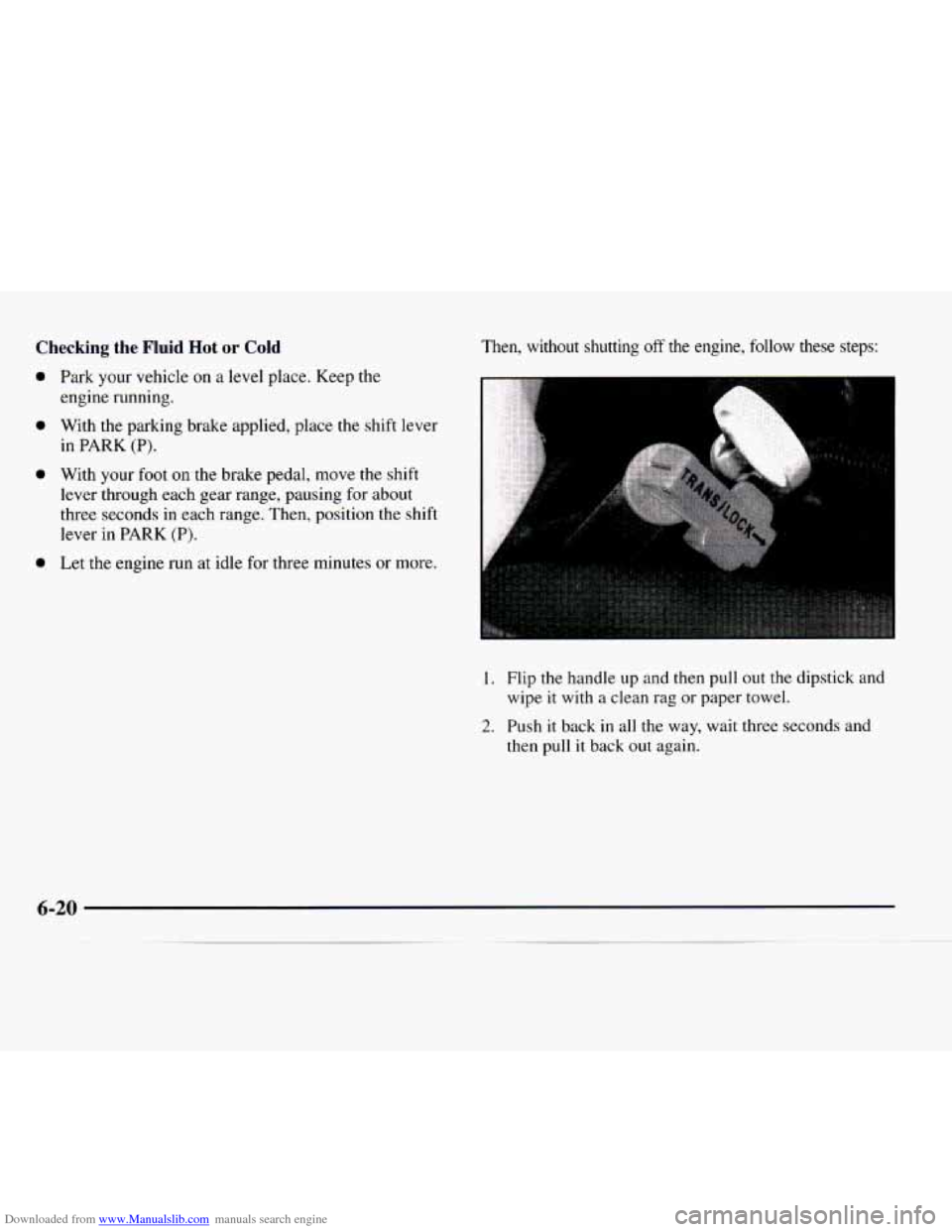
Downloaded from www.Manualslib.com manuals search engine Checking the Fluid Hot or Cold
0
0
0
0
Park your vehicle on a level place. Keep the
engine running.
With the parking brake applied, place
the shift lever
in PARK
(P).
With your foot on the brake pedal, move the shift
lever through each gear range, pausing for about
three seconds
in each range. Then, position the shift
lever in PARK
(P).
Let the engine run at idle for three minutes or more.
Then, without shutting off the engine, follow these steps:
A i
1. Flip the handle up and then pull out the dipstick and
wipe it with
a clean rag or paper towel.
2. Push it back in all the way, wait three seconds and
then pull
it back out again.
Page 350 of 386
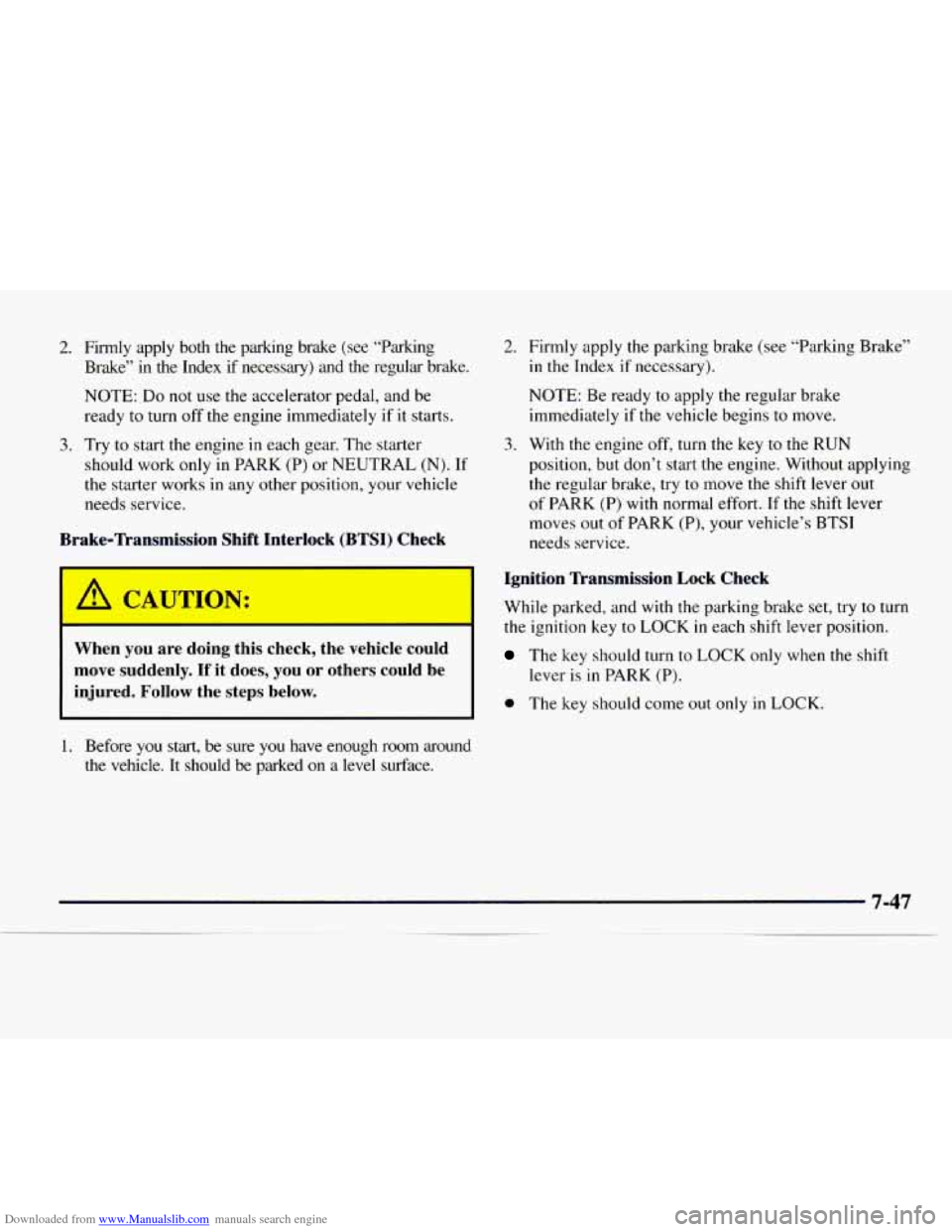
Downloaded from www.Manualslib.com manuals search engine 2. Firmly apply both the parking brake (see “Parking Brake” in the Index if necessary) and the regular brake.
NOTE: Do not use the accelerator pedal, and be
ready
to turn off the engine immediately if it starts.
3. Try to start the engine in each gear. The starter
should work only in PARK (P) or NEUTRAL
(N). If
the starter works in any other position, your vehicle
needs service.
Brake-Tra- -mission Shift Interlock (BTSI) Check
/! CAUTION:
When you are doing this check, the vehicle could
move suddenly. If it does, you or others could be
injured. Follow the steps below.
1. Before you start, be sure you have enough room around
the vehicle.
It should be parked on a level surface.
2.
3.
Firmly apply the parking brake (see “Parking Brake”
in the Index if necessary).
NOTE: Be ready
to apply the regular brake
immediately if the vehicle begins
to move.
With the engine
off, turn the key to the RUN
position, but don’t start the engine. Without applying
the regular brake, try to move
the shift lever out
of PARK (P) with normal effort. If the shift lever
moves out of PARK
(P), your vehicle’s BTSI
needs service.
Ignition Transmission Lock Check
While parked, and with the parking brake set, try to turn
the ignition key
to LOCK in each shift lever position.
The key should turn to LOCK only when the shift
0 The key should come out only in LOCK.
lever is in PARK (P).
Page 351 of 386
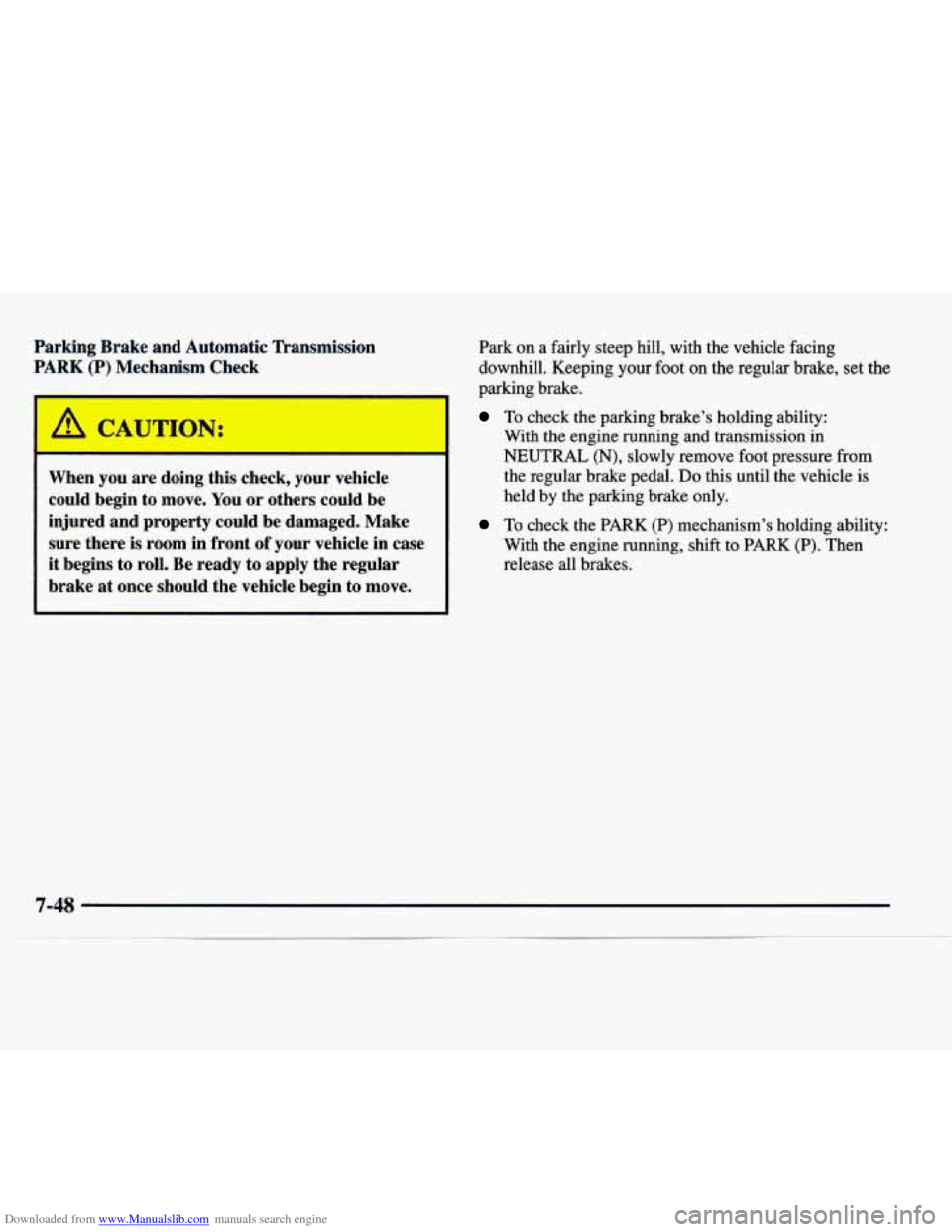
Downloaded from www.Manualslib.com manuals search engine Parking Brake and Automatic Transmission
PARK (P) Mechanism Check
I A CAUTION:
When you are doing this check, your vehicle
could begin to move. You or others could be
injured and property could be damaged. Make
sure there is room in front
of your vehicle in case
it begins to roll. Be ready to apply the regular
brake at once should the vehicle begin to move.
Park on a fairly steep hill, with the vehicle facing
downhill. Keeping your foot
on the regular brake, set the
parking brake.
To check the parking brake’s holding ability:
With the engine running and transmission in
NEUTRAL (N), slowly remove foot pressure from
the regular brake pedal.
Do this until the vehicle is
held by the parking brake only.
To check the PARK (P) mechanism’s holding ability:
With the engine runnine. shift
to PARK (P). Then
release all brakes.
7-48
Page 353 of 386
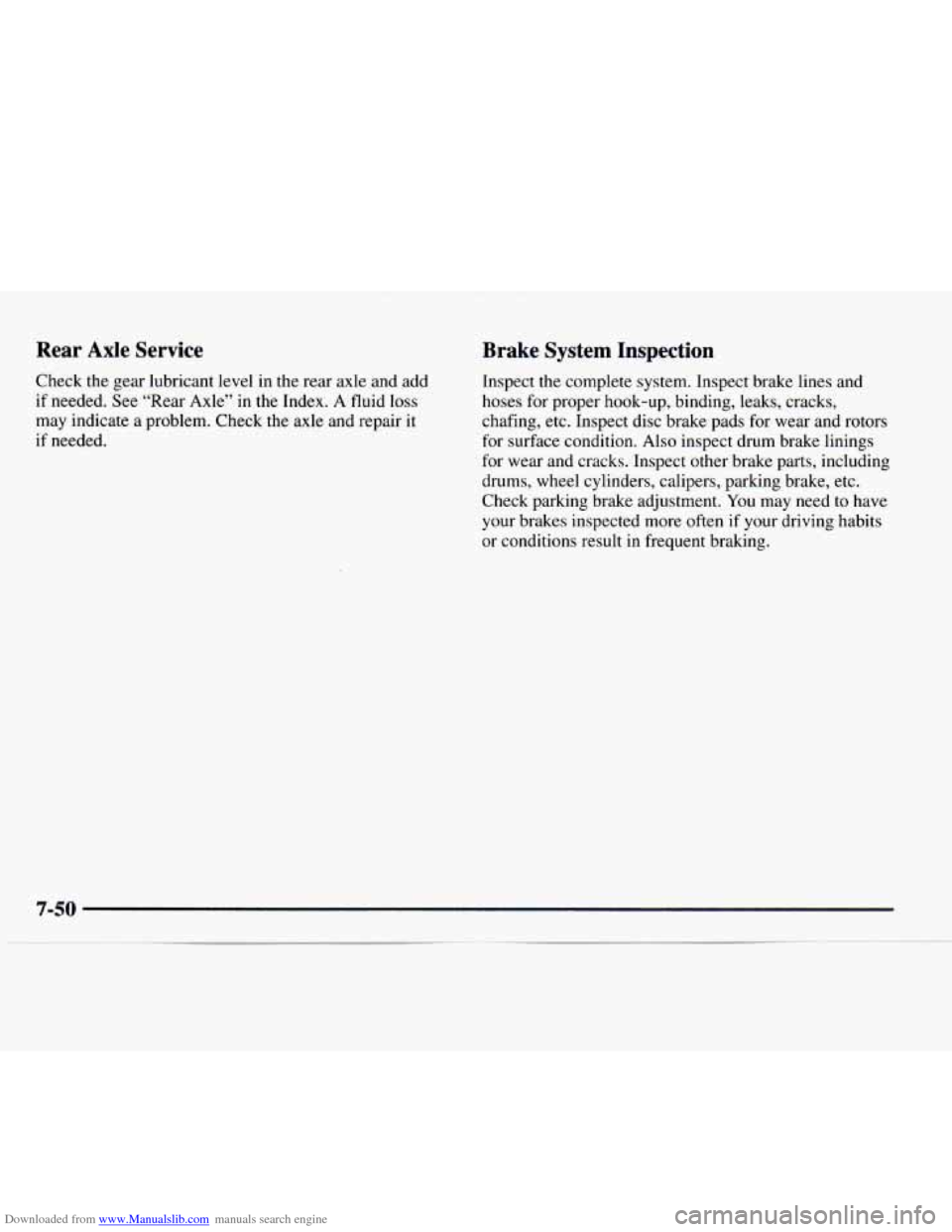
Downloaded from www.Manualslib.com manuals search engine Rear Axle Service
Check the gear lubricant level in the rear axle and add
if needed. See “Rear Axle”
in the Index. A fluid loss
may indicate a problem. Check the axle and repair it
if needed.
Brake System Inspection
Inspect the complete system. Inspect brake lines and
hoses for proper hook-up, binding, leaks, cracks,
chafing, etc. Inspect disc brake pads for wear and rotors
for surface condition. Also inspect drum brake linings
for wear and cracks. Inspect other brake parts, including
drums, wheel cylinders, calipers, parking brake, etc.
Check parking brake adjustment.
You may need to have
your brakes inspected more often if your driving habits
or conditions result in frequent braking.